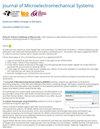Novel Area-Changed Capacitive Methods for Simultaneous Displacement Transducing and Force Balance in a Nano-g MEMS Accelerometer
IF 2.5
3区 工程技术
Q2 ENGINEERING, ELECTRICAL & ELECTRONIC
引用次数: 0
Abstract
High-precision MEMS accelerometers with nano-g resolution are emergent instruments for geophysical applications and proved their competence in terms of functionality. The electromagnetic actuator, which serves as an auxiliary component in nano-g MEMS accelerometers for improving the dynamic response, faces the challenges of process incompatibility, temperature sensitivity, and large form factor. Thereby, this paper proposes an area-changed capacitive method for both displacement transducing and force balance in a nano-g MEMS accelerometer, aiming to address those posed challenges and provide favourable performance. Thanks to the allowed large displacement range in the sensitive direction of the proposed device, the area-changed capacitive mechanism is able to be integrated with a highly-sensitive quasi-zero stiffness spring-mass structure. As a result, the fabricated force-balance MEMS accelerometer attains a calibrated self-noise of 1.3 ng/在纳米重力微机电系统加速度计中同时实现位移传导和力平衡的新型面积变化电容方法
具有纳米 g 分辨率的高精度 MEMS 加速计是地球物理应用中的新兴仪器,其功能性已得到证明。电磁致动器作为纳米 g MEMS 加速度计的辅助元件,用于改善动态响应,但面临着工艺不兼容、温度敏感性和外形尺寸大等挑战。因此,本文提出了一种面积变化电容方法,用于纳米克 MEMS 加速度计中的位移转换和力平衡,旨在应对这些挑战并提供良好的性能。由于所提议的装置在灵敏方向上允许较大的位移范围,区域变化电容机制能够与高灵敏度的准零刚度弹簧-质量结构集成在一起。因此,所制造的力平衡 MEMS 加速计的校准自噪声为 1.3 ng/ $\surd $ Hz,是迄今为止所报道的灵敏度最高的基于 MEMS 的加速计之一。另一方面,与开环配置中的 15.7 秒相比,采用静电闭环控制后的沉降时间缩短至 0.5 秒。此外,计算得出 "拉入 "边界的临界加速度输入为 5.4 g,可适应大多数地球物理应用。这项工作在地震监测或重力测量等地球物理应用中具有相当大的潜力,有望成为高性能闭环 MEMS 加速度计。[2023-0161]
本文章由计算机程序翻译,如有差异,请以英文原文为准。
求助全文
约1分钟内获得全文
求助全文
来源期刊

Journal of Microelectromechanical Systems
工程技术-工程:电子与电气
CiteScore
6.20
自引率
7.40%
发文量
115
审稿时长
7.5 months
期刊介绍:
The topics of interest include, but are not limited to: devices ranging in size from microns to millimeters, IC-compatible fabrication techniques, other fabrication techniques, measurement of micro phenomena, theoretical results, new materials and designs, micro actuators, micro robots, micro batteries, bearings, wear, reliability, electrical interconnections, micro telemanipulation, and standards appropriate to MEMS. Application examples and application oriented devices in fluidics, optics, bio-medical engineering, etc., are also of central interest.
 求助内容:
求助内容: 应助结果提醒方式:
应助结果提醒方式:


